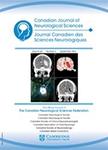版权所有:内蒙古大学图书馆 技术提供:维普资讯• 智图
内蒙古自治区呼和浩特市赛罕区大学西街235号 邮编: 010021

作者机构:GF Strong Rehabil Ctr Vancouver BC Canada Univ British Columbia Div Phys Med & Rehabil Vancouver BC Canada Univ British Columbia Fac Med Vancouver BC Canada Univ Alberta Glenrose Rehabil Hosp Edmonton AB Canada Univ Alberta Div Phys Med & Rehabil Edmonton AB Canada Montreal Gen Hosp Stroke Prevent Clin Montreal PQ Canada McGill Univ Ctr Hlth Montreal PQ Canada Western Univ St Josephs Hlth Care London London ON Canada West Pk Healthcare Ctr Toronto ON Canada Univ Toronto Phys Med & Rehabil Toronto ON Canada Stan Cassidy Ctr Fredericton NB Canada Dalhousie Univ Div Phys Med & Rehabil Halifax NS Canada Univ Calgary Dept Clin Neurosci Calgary AB Canada Univ Manitoba Dept Internal Med Sect Phys Med & Rehabil Winnipeg MB Canada Univ Saskatchewan Dept Phys Med & Rehabil Saskatoon City Hosp Saskatoon SK Canada Reg Rehabil Ctr Hamilton ON Canada Hotel Dieu Shaver Hlth & Rehabil Ctr St Catharines ON Canada Foothills Med Ctr Calgary AB Canada Dept Clin Neurosci Calgary AB Canada Univ Calgary Calgary AB Canada Inst Rehabil & Phys Impairment Quebec City Quebec City PQ Canada Laval Univ Quebec City PQ Canada
出 版 物:《CANADIAN JOURNAL OF NEUROLOGICAL SCIENCES》
年 卷 期:2020年第47卷第5期
页 面:589-593页
核心收录:
主 题:Spasticity Physical medicine and rehabilitation COVID-19 pandemic Guidance
摘 要:Background Spasticity is a common sequela of upper motor neuron conditions that can reduce quality of life, impair function, and heighten economic burden.1 Identification and treatment of problematic spasticity is key in order to decrease impairments including contracture formation, pain, skin breakdown, and functional decline and to limit disability.2 The COVID-19 pandemic has affected health-care systems worldwide including physical medicine and rehabilitation (PMR) and neurology practices in Canada.3-5 Inpatient hospital care for the management of patients with COVID-19 has been prioritized, while elective surgeries and outpatient clinics have been limited or canceled as part of resource allocation management and mitigation of risks during the pandemic. Telemedicine is obviously limited due to the inability to perform a full physical examination to adequately assess spasticity, tone, and contracture, and in certain clinical scenarios, in-person assessment becomes essential to ensure appropriate treatment. The SEMI-URGENT GROUP classified as a need for in-person assessment between 48 hours and 4 weeks and includes clinical scenarios where spasticity is worsening over the last 4 weeks and is associated with deteriorating functions such as mobility (including falls and difficulty with transfers), perineal care/hygiene with increased caregiver needs, and/or inability to function independently; increasing severe pain that is uncontrolled with other measures and has previously responded to chemodenervation; increased risk of joint dislocation; development of new or worsening pressure ulcer or wound; inability to don and doff orthoses required for function; impaired seating with increased pain and/or high risk of skin breakdown; loss of joint range of motion affecting function, skin breakdown, and/or contracture development. Given the current outbreaks in long-term care (LTC) facilities, we recommend not to transfer patients from LTC or other assisted living and grou